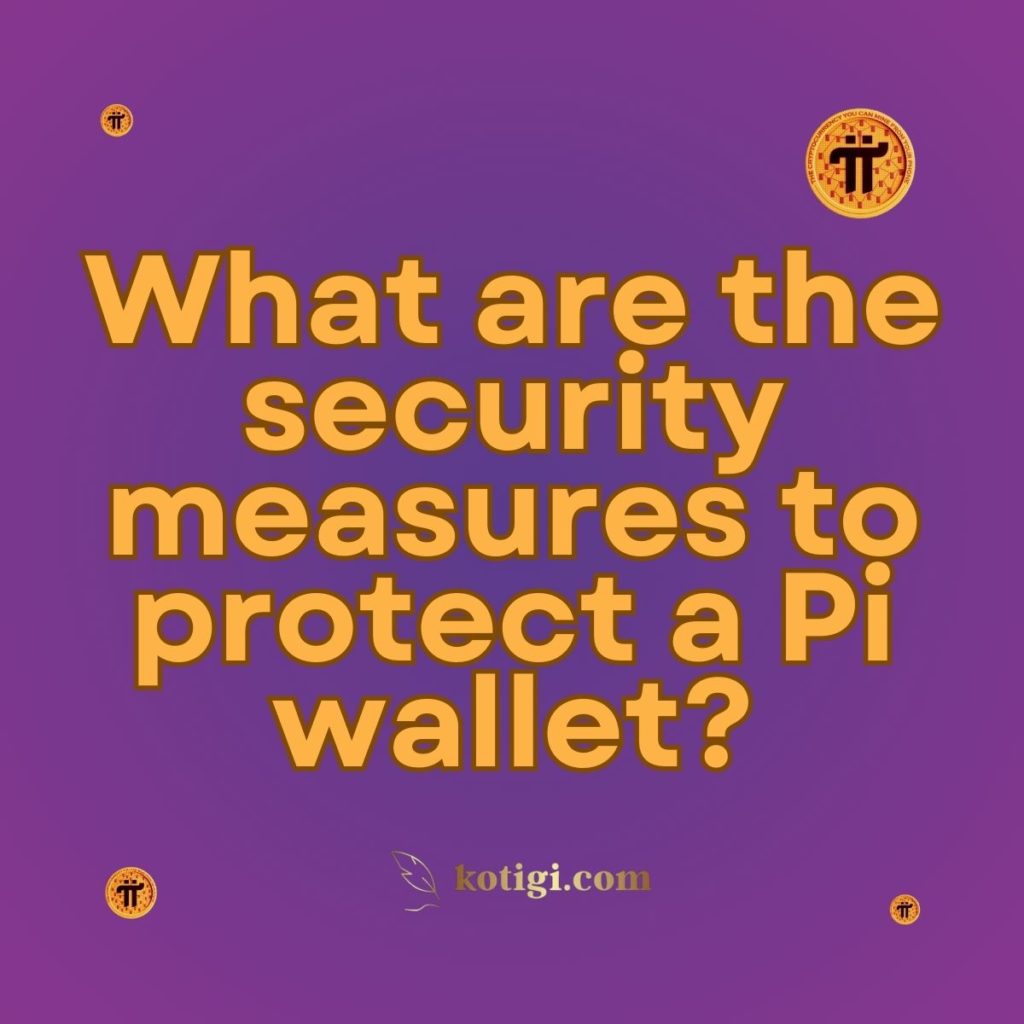
What is Pi Network?
Pi Network employs several security measures to ensure the protection of user wallets, including password protection, two-factor authentication (2FA), decentralized validation systems, and end-to-end encryption. Additionally, users can enhance their security by adopting good practices, such as regularly updating their credentials and storing backup passphrases securely.
Introduction
As the Pi Network continues to grow in popularity, ensuring the safety and security of its users’ digital wallets is a top priority. In the world of cryptocurrencies, wallet security is critical as it holds the keys to users’ assets and identity on the network. This article will examine the various security measures that Pi Network has implemented to safeguard wallets and provide best practices for users to keep their digital assets secure.
Table of the security measures Pi Network implements compared to other blockchain technologies
Here’s a table that compares the security measures of Pi Network with other popular blockchain networks to highlight how Pi Network addresses wallet security and energy efficiency.
| Security Measure | Pi Network | Bitcoin | Ethereum | Cardano |
|---|---|---|---|---|
| Password Protection | Strong password requirements with backup passphrase for recovery. | Password is required to access wallet software; recovery via seed phrase. | Requires password for wallet software access and seed phrase for recovery. | Strong password protection with recovery options using seed phrase. |
| Two-Factor Authentication (2FA) | Available through SMS, email, or Google Authenticator for added security. | Not natively available; users must rely on third-party apps for 2FA. | Not natively available; users rely on third-party apps for 2FA. | Not natively available; users rely on third-party apps for 2FA. |
| Private Key Encryption | End-to-end encryption of private keys stored securely on the user’s device. | Encrypted private keys stored locally or on hardware wallets. | Private keys are encrypted locally or on hardware wallets. | Encrypted private keys stored on the user’s device or hardware wallets. |
| Multi-Signature Wallet Support | Supported for increased transaction security and shared wallet control. | Supported, requiring multiple signatures for transactions. | Supported, allowing for increased security in transactions. | Supported, allowing for multiple parties to authorize transactions. |
| Trust Circles & Social Validation | Decentralized trust circles for transaction validation, reducing fraud. | No social validation system; relies solely on blockchain consensus. | No social validation system; uses blockchain consensus mechanisms. | No social validation system; relies on staking-based consensus. |
| Backup & Recovery | Provides users with backup passphrase for recovery; encourages offline storage. | Recovery via seed phrase, which should be stored securely offline. | Backup seed phrase for recovery; recommended to store offline. | Backup seed phrase for recovery; users should store offline for security. |
| Device Security & Antivirus | Emphasizes the importance of device security and antivirus protection for wallet safety. | Device security is the user’s responsibility; no built-in antivirus measures. | Device security is the user’s responsibility. | Strong emphasis on users securing their devices, but no built-in antivirus. |
| Hardware Wallet Support (Future) | Planned for future updates to increase security with physical wallets. | Supported through external hardware wallets (e.g., Ledger, Trezor). | Supported through external hardware wallets (e.g., Ledger, Trezor). | Supported through external hardware wallets. |
| Bug Bounty & Community Reporting | Encourages community participation in reporting security vulnerabilities through bug bounty programs. | Some exchanges and wallet providers offer bug bounties. | Large bug bounty programs in place for Ethereum-based projects. | Actively encourages bug bounty programs for community contributions. |
| Energy Efficiency & Low Resources | Energy-efficient, mobile-based mining model, reducing resource consumption. | High energy consumption due to proof-of-work (PoW) consensus. | Transitioning to proof-of-stake (PoS) to reduce energy usage. | Uses proof-of-stake (PoS), which is more energy-efficient than PoW. |
This table provides a clear comparison of the security measures Pi Network implements compared to other blockchain technologies. It demonstrates Pi Network’s commitment to wallet security, energy efficiency, and a user-friendly experience.
The Importance of Wallet Security
The Role of Wallets in Cryptocurrency
A cryptocurrency wallet is a digital tool that allows users to store, send, and receive digital currencies like Pi. In decentralized networks such as Pi, wallets are the key to accessing funds and interacting with the blockchain. Securing the wallet, therefore, becomes paramount to ensuring that users’ assets are safe from malicious actors.
- Key Ownership
Wallets work by storing a private key, which allows users to access and manage their digital coins. Losing control of the private key, or having it stolen, would give unauthorized parties access to the user’s funds. - Transaction Control
Wallets not only secure funds but also verify transactions on the Pi Network. Security vulnerabilities could allow hackers to manipulate transactions, compromising the integrity of the network. - Digital Identity
Wallets also serve as a form of digital identity on the blockchain, making their security essential to protecting user identity and personal data.
Security Features Provided by Pi Network
1. Password Protection
Pi Network’s first line of defense for wallet security is password protection. When users create a Pi wallet, they must generate a strong, unique password to prevent unauthorized access.
- Strong Password Requirements
Pi Network encourages users to choose complex passwords that include a combination of letters, numbers, and special characters. This helps prevent brute force attacks, where attackers try to guess the password. - Password Storage
It is essential that users do not share their passwords with anyone or store them in insecure locations, such as plain text files or unsecured devices. - Password Reset Mechanism
Pi Network provides a password reset option, but it is important for users to remember that the reset process requires authentication, often through a backup phrase, ensuring that only the rightful owner can recover access.
2. Two-Factor Authentication (2FA)
Two-factor authentication (2FA) is another critical security layer that Pi Network integrates into its wallet system. This ensures that access to the wallet requires two forms of verification.
- SMS or Email Authentication
When 2FA is enabled, users must enter a code sent to their registered phone number or email address before they can access their Pi wallet. This helps to mitigate unauthorized access, even if the user’s password is compromised. - Authenticator Apps
Pi Network also supports the use of authentication apps like Google Authenticator, which generate time-sensitive codes that are required to log in. These codes add an additional layer of security, ensuring that only the user with access to the authenticator app can log in. - Increased Protection Against Phishing
2FA helps protect against phishing attacks, where malicious actors attempt to steal users’ login credentials by posing as a legitimate service.
3. Trust Circles and Community Validation
Pi Network uses a decentralized security model called “trust circles” to verify the identity and authenticity of its users. This system ensures that transactions are validated by trusted members of the network.
- Building Trust Circles
Each Pi user is encouraged to form a trust circle, consisting of individuals they personally know. This system of social verification strengthens the network by ensuring that transactions are validated by real, trusted individuals rather than anonymous validators. - Preventing Fraud
The decentralized nature of trust circles reduces the risk of fraud by ensuring that no single entity controls the validation process. Multiple parties must agree on the legitimacy of a transaction, making it difficult for attackers to manipulate the system. - Accountability and Security
Since each user’s reputation is tied to their trust circle, there is a strong incentive for members to behave honestly, further reinforcing the security of the network.
Cryptographic Protection Mechanisms
1. Private Key Encryption
In Pi Network, as with other blockchain platforms, private keys are critical to accessing wallets and conducting transactions. Pi Network ensures the security of these keys through strong encryption practices.
- Private Key Storage
Private keys are encrypted and stored securely on users’ devices. This means that the keys never leave the device, reducing the risk of remote attacks. Only the user can access the private key, ensuring they maintain control over their wallet. - End-to-End Encryption
Pi Network uses end-to-end encryption to protect the communication between users and the network. This prevents third parties from intercepting or tampering with transaction data as it is transmitted. - Cryptographic Algorithms
Advanced cryptographic algorithms, such as elliptic curve cryptography (ECC), are used to secure the wallet and transactions. These algorithms ensure that even if a hacker were to intercept the data, it would be practically impossible to decrypt it without the private key.
2. Multi-Signature Transactions
To further enhance wallet security, Pi Network supports multi-signature transactions, which require more than one private key to authorize a transaction.
- Shared Control
Multi-signature wallets are particularly useful for organizations or groups of users who wish to share control over a single wallet. For example, transactions may require two out of three signatories to approve a transaction, adding an extra layer of protection. - Preventing Unauthorized Transfers
By requiring multiple signatures, Pi Network reduces the risk of unauthorized transfers. Even if one user’s private key is compromised, an attacker would still need the consent of other signatories to complete a transaction. - Enhanced Governance
Multi-signature transactions also enhance the governance of shared wallets, ensuring that funds are only used with the approval of all necessary parties.
User Practices for Enhanced Wallet Security
1. Secure Backup of Wallet Keys
It is critical for users to back up their wallet keys securely. In the event that a device is lost or damaged, having a secure backup ensures that users can recover access to their wallet and funds.
- Backup Passphrase
During the creation of a Pi wallet, users are provided with a backup passphrase, which serves as a recovery tool. This passphrase should be stored securely, preferably in a physical format, such as written down and kept in a safe place. - Avoid Cloud Storage
Storing backup phrases in cloud services or email accounts is not recommended, as these platforms can be vulnerable to hacking. Instead, users should use offline methods to store their backup information. - Regularly Updating Backups
If any changes are made to the wallet, such as resetting the password or generating a new private key, users should update their backup information to reflect these changes.
2. Device Security
Since Pi wallets are stored on users’ devices, it is essential to ensure that the device itself is secure.
- Software Updates
Keeping the device’s operating system and applications up to date helps protect against known security vulnerabilities. Regular updates patch security holes that could otherwise be exploited by hackers. - Anti-Malware Protection
Installing reliable antivirus and anti-malware software adds an additional layer of protection, preventing malicious software from compromising the device and gaining access to the wallet. - Avoiding Untrusted Networks
Users should avoid connecting to unsecured or public Wi-Fi networks when accessing their Pi wallet, as these networks may be vulnerable to man-in-the-middle attacks that intercept sensitive data.
Pi Network’s Commitment to User Security
1. Regular Security Audits
Pi Network undergoes regular security audits to ensure that its platform remains secure and free from vulnerabilities.
- Internal Audits
The Pi development team regularly conducts internal audits to identify potential security weaknesses. These audits help ensure that the platform’s security measures remain robust and effective. - Third-Party Assessments
In addition to internal audits, Pi Network collaborates with third-party cybersecurity experts to conduct independent assessments of its security architecture. These assessments provide an unbiased view of the platform’s security. - Continuous Improvement
Pi Network is committed to continually improving its security measures based on the results of these audits. As new threats emerge, the development team is proactive in addressing potential vulnerabilities and enhancing security features.
2. Community Reporting and Bug Bounties
Pi Network encourages its community to report any security vulnerabilities or bugs they encounter on the platform.
- Bug Bounty Programs
To incentivize community participation, Pi Network runs a bug bounty program, rewarding users who discover and report security vulnerabilities. This approach leverages the collective expertise of the community to keep the platform secure. - Transparency and Accountability
By openly addressing security vulnerabilities and rewarding those who help improve the platform, Pi Network fosters transparency and accountability. This builds trust among users and reassures them that the development team is actively safeguarding their assets. - Rapid Response to Threats
When a security issue is reported, Pi Network’s development team works swiftly to address it. This rapid response ensures that vulnerabilities are patched before they can be exploited by malicious actors.
Future Enhancements in Pi Network Security
As the Pi Network continues to evolve, the development team is exploring additional security enhancements to keep users’ wallets safe.
1. Hardware Wallet Support
In the future, Pi Network may introduce hardware wallet support, offering users a more secure way to store their private keys offline.
- Physical Security
Hardware wallets store private keys in a physical device that is not connected to the internet, making them immune to remote hacking attempts. Users would still need to physically possess the wallet to access their funds. - Additional Security Layer
Adding hardware wallet support would provide an additional layer of security for users with significant Pi holdings, offering them peace of mind that their assets are protected by the highest level of security.
2. Advanced Biometric Authentication
Pi Network may also integrate advanced biometric authentication methods, such as fingerprint or facial recognition, to enhance wallet security.
- Enhanced User Convenience
Biometric authentication offers a convenient and secure way to access wallets, eliminating the need to remember complex passwords. - Increased Security
Since biometric data is unique to each user, integrating this feature would make it significantly more difficult for unauthorized parties to gain access to users’ wallets.
Conclusion
Pi Network has implemented a comprehensive suite of security measures to protect user wallets from unauthorized access and ensure the integrity of its transactions. Through password protection, two-factor authentication, private key encryption, and decentralized trust circles, Pi Network prioritizes the security of its users’ assets. By adopting best practices, such as secure backup storage and device protection, users can further enhance their wallet security and protect their digital identity on the Pi Network.
As the platform continues to evolve, Pi Network remains committed to introducing new security enhancements, ensuring that its users’ wallets remain secure in the ever-changing landscape of cryptocurrency.
Key Takeaways
- Pi Network utilizes password protection, two-factor authentication (2FA), and private key encryption to secure wallets.
- Users can strengthen their wallet security by storing backup passphrases offline and securing their devices.
- Multi-signature wallets and trust circles provide an added layer of protection, preventing unauthorized transactions.
- Pi Network conducts regular security audits and offers bug bounty programs to maintain platform integrity.
- Future security enhancements may include hardware wallet support and biometric authentication for added protection.





